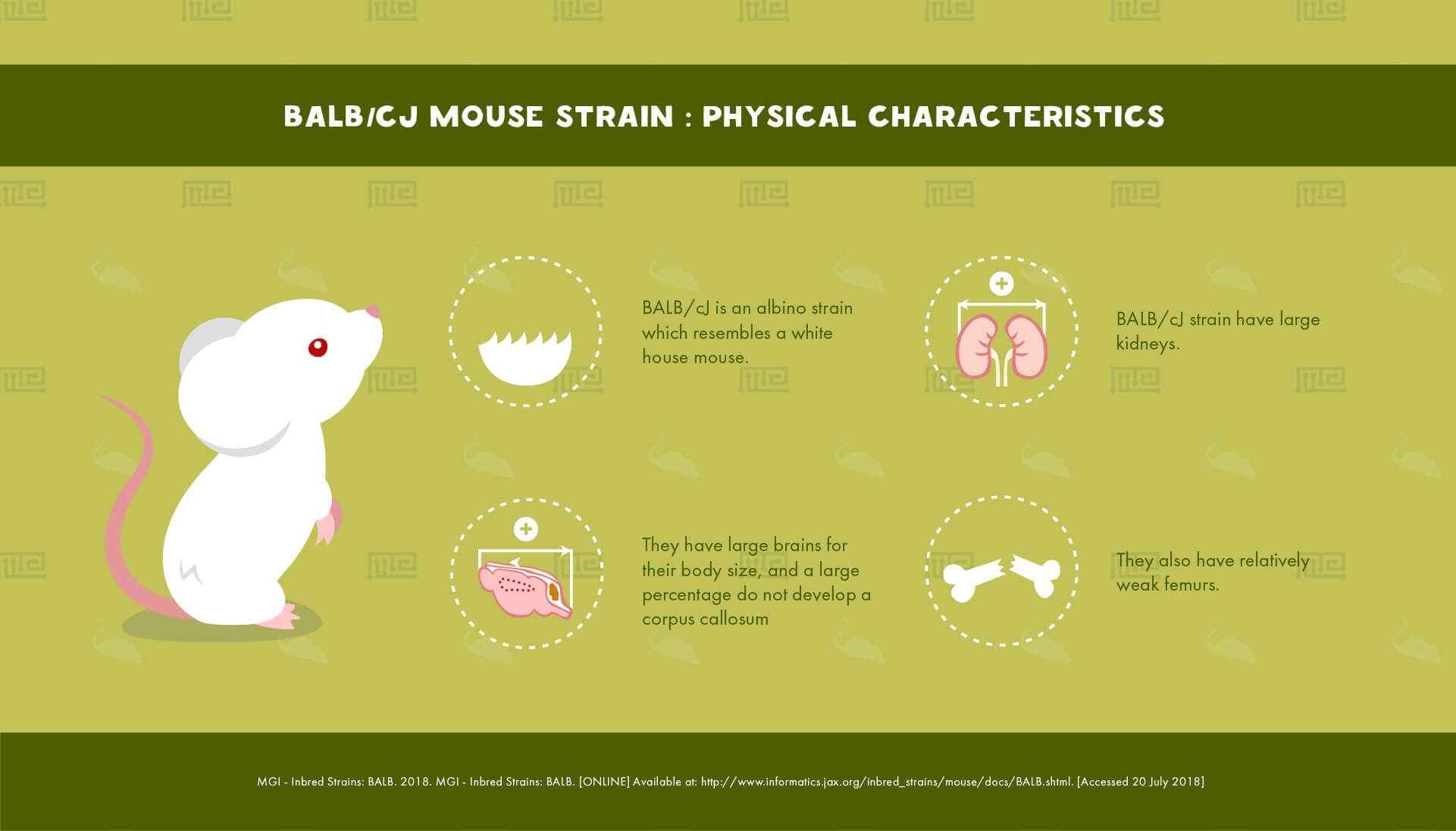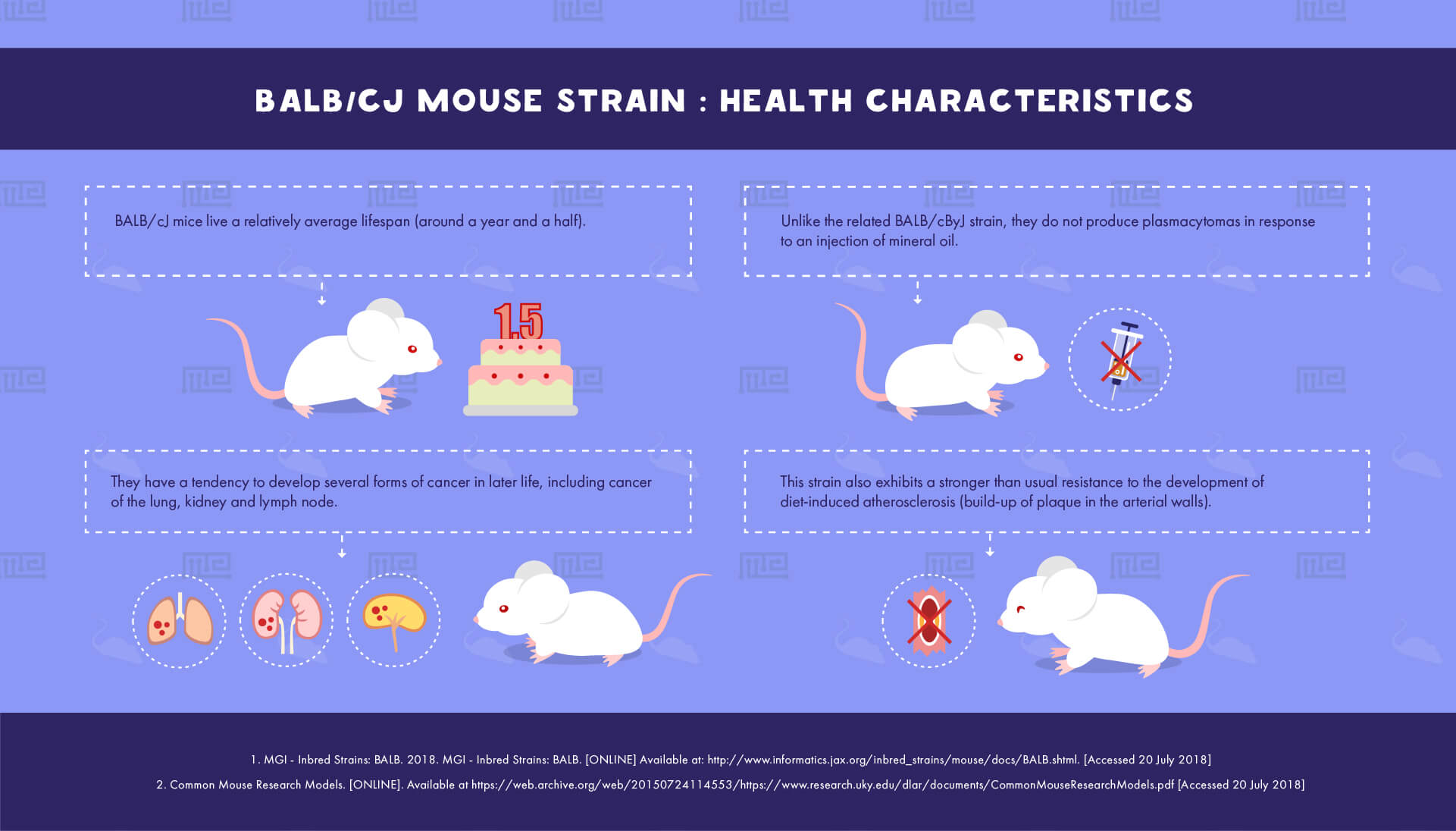Overview
The BALB/cJ is one of the most well established and commonly used strains in scientific experimentation with mouse models. Over two hundred generations of this inbred strain have passed since it was first developed. They have proved central to immunological and cancer research.[1]
History
The BALB/cJ strain derives from the BALB/c strain, which was developed from a colony established in New York in the early 1920s. In the 1930s, production of the strain moved to the Jackson Laboratory, where it has remained until today. All remaining individuals of the original strain died in a fire in 1947, but two sub-strains—BALB/cJ and BALB/cByJ—survived, and all current BALB/c mice are derived from these stocks.[1]
Physical Characteristics
BALB/cJ is an albino strain which resembles a white house mouse. They have large brains for their body size, and a large percentage do not develop a corpus callosum (the main connecting tissue between the two hemispheres of the brain). They also have large kidneys and relatively weak femurs.[2]
Behavioral Characteristics & Handling
BALB/cJ mice are noted for their more pronounced than usual aggressive tendencies, more aggressive than the related BALB/cByJ strain; males of the BALB/cJ strain tend to fight when housed together. The strain also displays heightened anxiety. Experimenters have observed that BALB/cJ mice remain immobile for longer than other strains in the forced swimming test and that they perform poorly at shock avoidance learning.[2]
As a consequence of their heightened aggression, and also increased locomotor activity,[3] it is to be expected that individuals of this strain will be harder to capture, as well as more likely to bite when restrained in the hand. Despite extensive documentation of its aggression, no data could be found in peer-reviewed literature about the ease of handling of this strain, so precaution is advised.
Health Characteristics
BALB/cJ mice live a relatively average lifespan (around a year and a half).[2] They have a tendency to develop several forms of cancer in later life, including cancer of the lung, kidney and lymph nodes. Unlike the related BALB/cByJ strain, they do not produce plasmacytomas in response to an injection of mineral oil. This strain also exhibits a stronger than usual resistance to the development of diet-induced atherosclerosis (build-up of plaque in the arterial walls).[4]
Major Experimental Uses
As mentioned above, BALB/cJ mice are frequently used in cancer research due to their tendency to develop a variety of types of tumor. They are also very often used for immunological research, partly because of how they exhibit TH2-biased immune responses (i.e. immune responses with more class 2 T helper lymphocytes). The TH2-biased response can lead to inflammation of the lungs, which also allows this strain to be used as a model for asthma research. Finally, their tendency to develop plasmacytomas means they are useful for monoclonal antibody production.[1][2]
References
- 000651 – BALB/cJ. 2018. 000651 – BALB/cJ. [ONLINE] Available at: https://www.jax.org/strain/000651. [Accessed 20 July 2018].
- MGI – Inbred Strains: BALB. 2018. MGI – Inbred Strains: BALB. [ONLINE] Available at: http://www.informatics.jax.org/inbred_strains/mouse/docs/BALB.shtml. [Accessed 20 July 2018].
- Sabrina van Heukelum. Beyond Aggression: Characterising the Phenotype of
- the BALB/cJ Mouse. 2017. Nijmegen CNS. Vol. 12. Issue 1.
- Common Mouse Research Models. [ONLINE]. Available at https://web.archive.org/web/20150724114553/https://www.research.uky.edu/dlar/documents/CommonMouseResearchModels.pdf [Accessed 20 July 2018]


